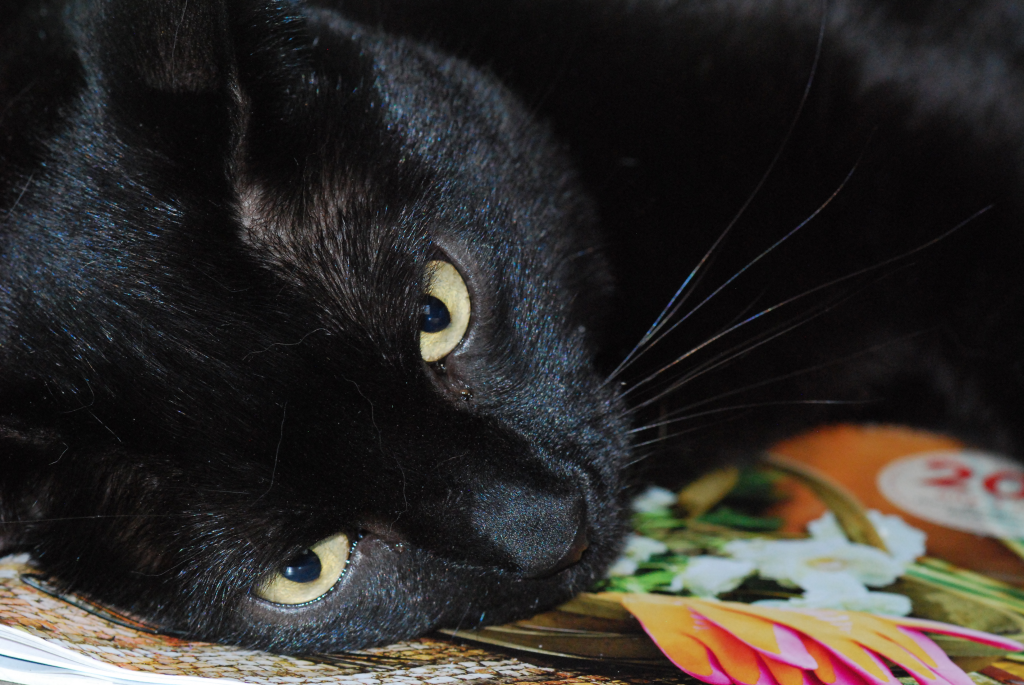I enjoy photography, among other things. I really enjoy being out in nature, but being the spoiled human I am, I don’t do camping and such. I want indoor plumbing, TYVM 🙂 When I am out in nature, I am trekking along (or maybe just standing looking) enjoying my surroundings or looking at the stars and planets or a meteor shower (if night, hahaha). I have a medium good(?) telescope that fascinates me, when I feel like setting it up to use. I have a photo of a lunar eclipse I took several years ago at my then home. I’ll look around and try to find that image. The moon really does turn that burned reddish color. It is a free-hand shot because really, you don’t need a telescope to see the shadow move across the moon. My current home is much farther from a large city center, but it’s hardly dark sky country and there’s a LOT of trees. I can see more of the constellations here, but don’t need the telescope to do that. I am basically lazy, remember.
This post is to “show off” some nature macro-photography I’ve taken over the last several years. I will/may put general photographs here later, or in a separate post later. Be warned, THERE ARE SPIDERS. I love the different colors on them and patterns both on their bodies and in their webs. I call them all (mostly) ‘garden spiders’. If spiders bother you I suggest you leave now (but you’ll miss some pretty shots). Also note, the images may not be cell phone friendly. I aimed this post for a decent computer screen, large touch screen even better(?), to show as much detail as possible. Photos all taken with the DSLR body (Nikon D-80) Brad bought for me many years ago. It is the digital replacement for the film camera body I had, so all my existing peripherals still work. The photos have been cropped, but not manipulated, color corrected, photo-shopped, or otherwise altered. To ‘resize’ or ‘crop’, I use MS paint (nope, not the 3D version). Cropping an image makes the extraneous areas vanish, so you’re left with the main subject you intended. Photos were taken using various camera settings, from ‘manual’ to auto-focus and almost everything in between. I used lenses 35mm-70mm f/3.3:4.5, 105mm f/2.8 macro (new to the digital body) and maybe the 10-24mm wide angle zoom (a few years after the digital body), all with a clear or polarizing lens protector/filter (Promaster or Nikkon) and sun flare hood if needed. None of these images (I don’t think) used the 75-300mm f/4.5 zoom lens. I don’t think I used the TC-201 2x teleconverter (also new to the digital body) on any of these. either. Okay, enough about the tech details of what dedicated photography equipment I have available. I am not counting cell phone or tablet computer and such as photography equipment – there is just no comparison.
Keep in mind these are the photos I like best of the hundreds and hundreds of attempts. I worked hard to get these; sharp, in focus, the “right” light, the point of view, all that while under pressure that the subject was going to move. Be respectful of my work — All Images Copyright Gail Dobson. Not having to pay for film developing gives so much freedom to learn and explore and experiment. As an aside, I personally think the film image is more true to life (warmer, less “sharpness” among shadows and between the light). Kinda like I think my favorite recording of the 1812 Overture (and “I Love Rock & Roll” and “Back In Black” and “Rub It In”, and “Stand On It” and… ok, all of it) sounds best on vinyl. However, the absolute convenience and “I want it now” satisfaction and portability, in the case of audio, in digital form really can’t be beat. Like so much in life, sometimes it’s a trade off. The images are not in any particular date order. Maybe later for that, maybe.
So how about some photos? I’ll *try* to tell a bit about each (that I remember, anyway); the originals are dated from when they transferred to the computer so I can’t even be positive of that. I am pretty good about naming them though. I don’t usually store the .raw files because of space and I don’t have an editor to open them, anyway. Not sure they’d keep their dates… ah, it’s in the file name, never mind. Description is above each photo. Many resized down for display purposes (12+ MG a bit much for web page). Cropped unless otherwise indicated.
I’m sure this one was late last (2019) summer, late afternoon facing east, at back edge of deck. The baby garden spider is just beginning to show its markings and seemed proud of itself for capturing the …cabbage white(?) butterfly. Butterfly’s wings look pretty tattered. I don’t know if due to age (it was going to die soon anyway) or it fought to free itself. The spider didn’t like me being so close, but I already had the 35-70mm mounted. Spider baby kept hiding from me and I was losing the light of the lowering sun. I don’t like that I couldn’t get a little of the web in the shot — it was a pretty pitiful web as these things go. It went a long way though, way longer than this image shows; behind the right hand bloom probably 3ft total length over to the deck rail. I’m not even positive it’s this little guy’s web for that matter. The plant is purple coneflower (Echinacea purpurea). You can see it still has yellow pollen of its own and some other plant’s white pollen on its petals. A bit of web material is on one of the petals. 35-70mm
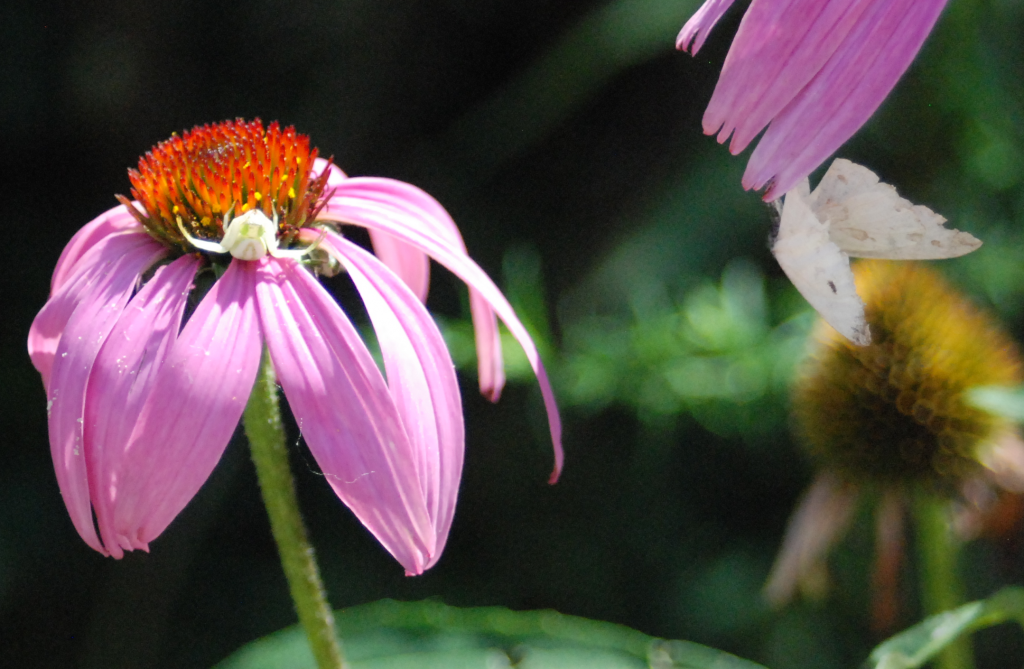
I show this next one as an example of how difficult it is to get the auto-focus right. In the late summer, 2018 I decided I’d tag the Monarchs that I “rescued” and raised. I’ve raised them before (I have photos back to 2014), only the last batch for this geographic area, but had never tagged them. I was documenting each (a total of about 2 dozen, I think) from egg or whichever instar I’d found them, through tagging and release. Notice the camera decided to focus on my finger instead of either of the caterpillars. That was a bit frustrating. The black spot is either a pinch (blood blister) or may be caterpillar poop (frass). BTW, am I the only one who wonders why different critters’ poops have different names? No, I don’t just mean different words for ‘poop’, or euphemisms for ‘fertilizer’. Frass (caterpillars), guano (bats), castings (earth worms), scat (most wild carnivores); and even fossilized ‘poop’ is called coprolites. So, hatchling and first instar Monarch caterpillars (and the wide part of my finger in perfect focus). They’re on butterfly weed (Asclepias tuberosa); they only eat milkweed leaves, several varieties. See the slight fuzz of the leaf; same distance as my finger, same focus. You can see how hard I’m pinching to hold the leaf still so they don’t fall. The larger one hadn’t “grabbed” it yet. Brad took this photo; standard 35-70mm lens.
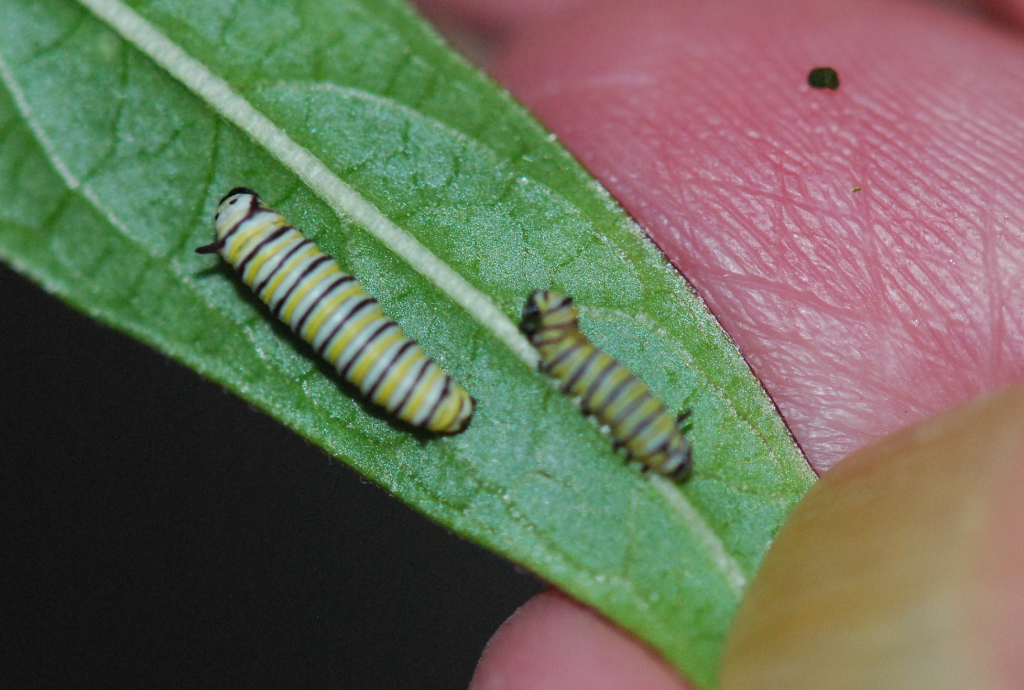
This little skipper was taken Sept, 2014. It’s the first time I noticed #1 how hairy they are and #2 the sun glinting on its proboscis. Yes, it’s a whole angle thing, but I thought it looked neat. Follow the (dark) curve around to come back to the end in the bloom. Yes, I could have cropped this closer but then you wouldn’t see what the mistflower actually looks like 🙂 Probably the 35-70mm.
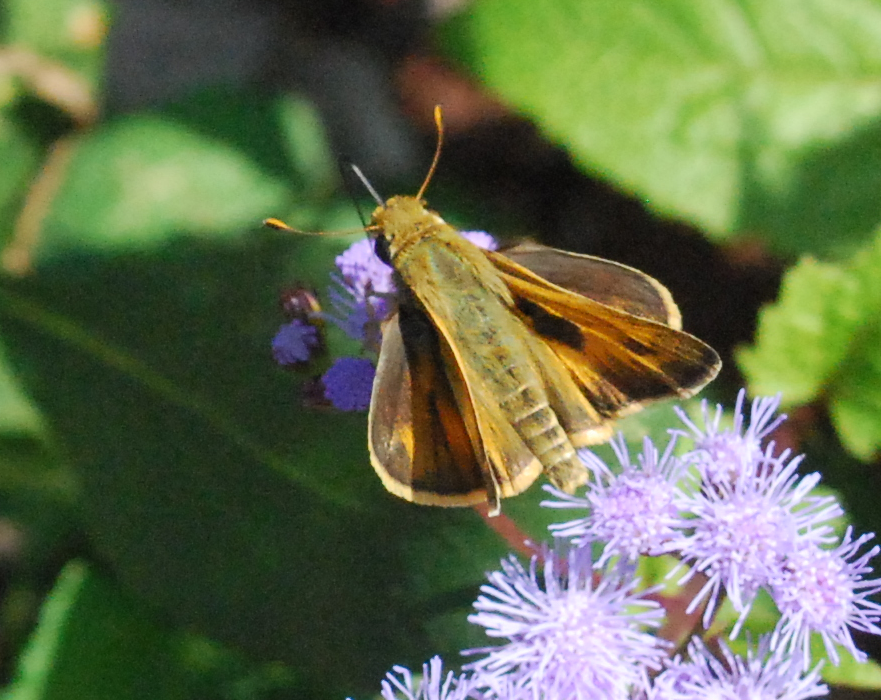
This is how they usually carry the proboscis, tightly curled. I think this was taken the following year (2015). It’s on A. tuberosa, butterfly weed. The adults will nectar where ever there’s sugar; their larva (caterpillars) only eat Asclepias leaves, of several varieties; A. incarnata (swamp milkweed, pink blooms) or A. syriaca (common milkweed usually white blooms) seem to be their favorites here. Farmers have been killing milkweed plants for years; further adding to the pressures facing the monarchs. The monarch is a much larger butterfly than the skipper. Probably the 35-70mm.

This image and the next I think are different species garden spider, but both built their webs right near the frog pond. Apparently there’s good hunting there. It is like the smaller one in the (maybe) male & female pair further below, but this one’s top back markings don’t match that one. There are several different types of “garden” spider, nearly as I can tell. They all share the signature zig-zag pattern and less than geometric precision in their webs. Probably the 105mm, 2016-ish?
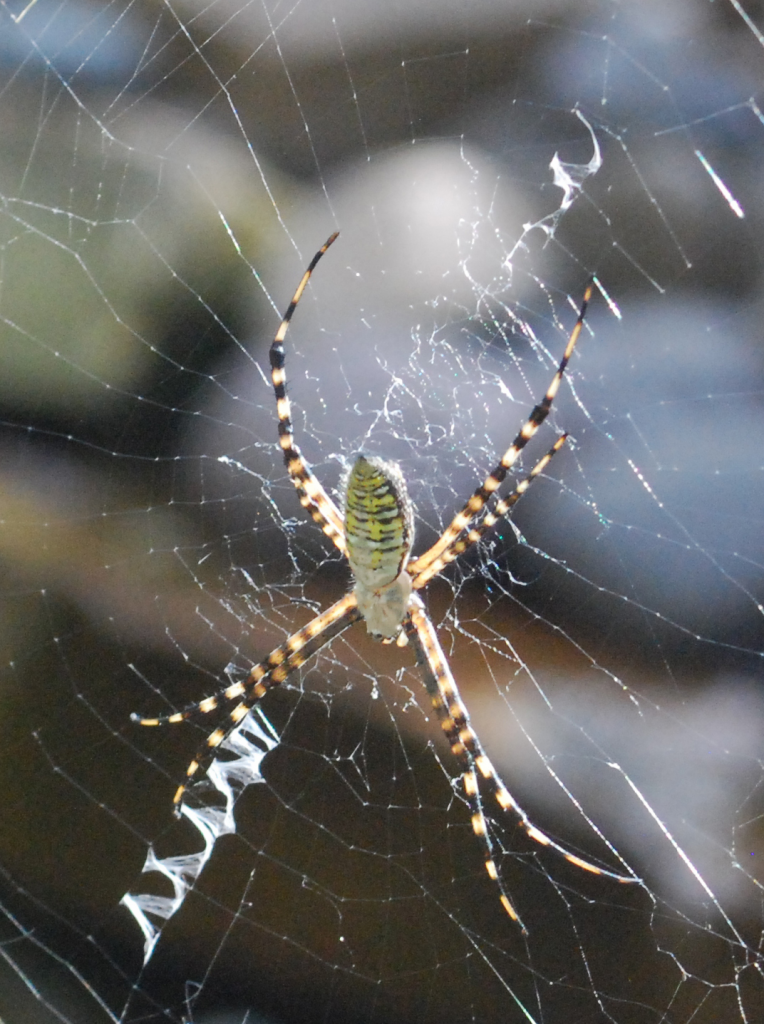
Underside of another spider same size as above. Patterns are so different though… but leg placement and markings are almost identical. I don’t remember the circumstances of taking these two pics and can’t tell from file names. They were not taken back to back I can tell from the DSC names they’re about a year apart. This one’s underside pattern looks a lot like the previous baby spider’s back pattern, to me. IDK that means anything at all. Probably the 105mm, about 2017 is best guess.
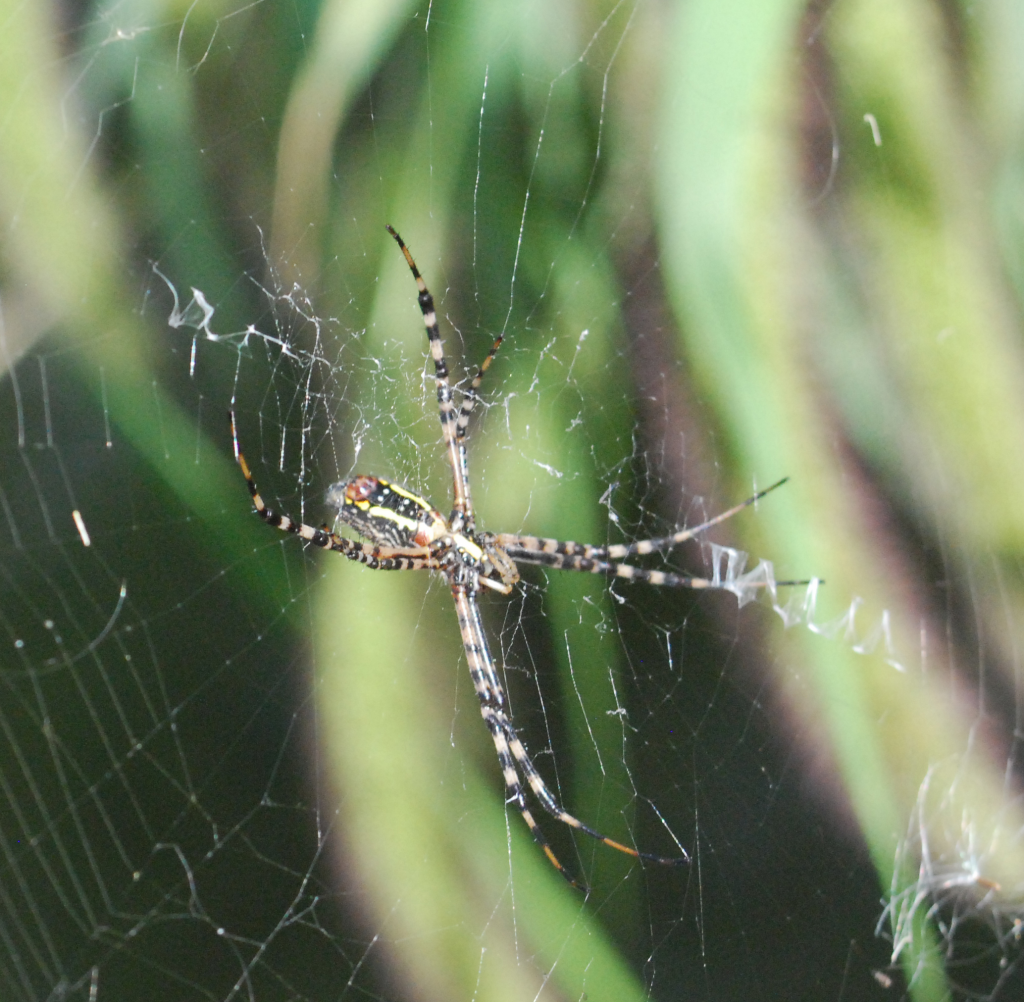
This one was interesting to take. There’s a web you can barely see on the underside of the top cover of the pergola. The smaller of these two kept darting at the larger, who seemed unimpressed. IDK courting of some sort? Challenge of some sort (you’re in my space)? I call them Male & Female, Maybe. Those front not ‘pincers’ look a little like described (the larger one is female and the smaller is male), maybe? Are they even the same species of ‘garden’ spider? IDK, but I like the pattern on both of them, and enjoyed the challenge of getting the shot against the sky like that. Possibly the 105mm, or maybe the 35-70mm. I remember doing it; it took a long time to get a decent shot that afternoon. I had seen the web that morning, on the east facing patio. No way was I going to try this directly facing the sun. Sept, 2014
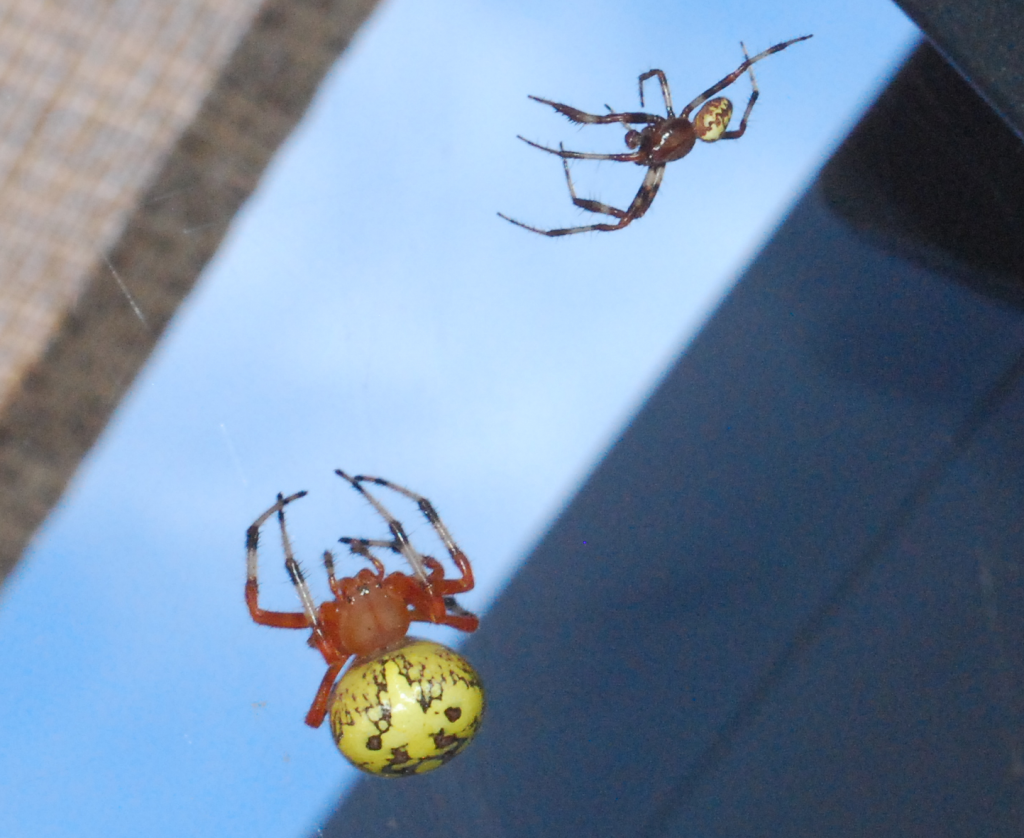
Garden spider, near the pond pump shed, summer-ish, 2017-ish? You can see the zig-zag again, and see how different this back pattern is from any of the others. I love the detail and sharpness here; all 8 legs, some sun glint off the web, his(?) front not pincer things (MD DNR knows stuff like this)… I like this one. Probably the 10-24mm, probably not cropped.
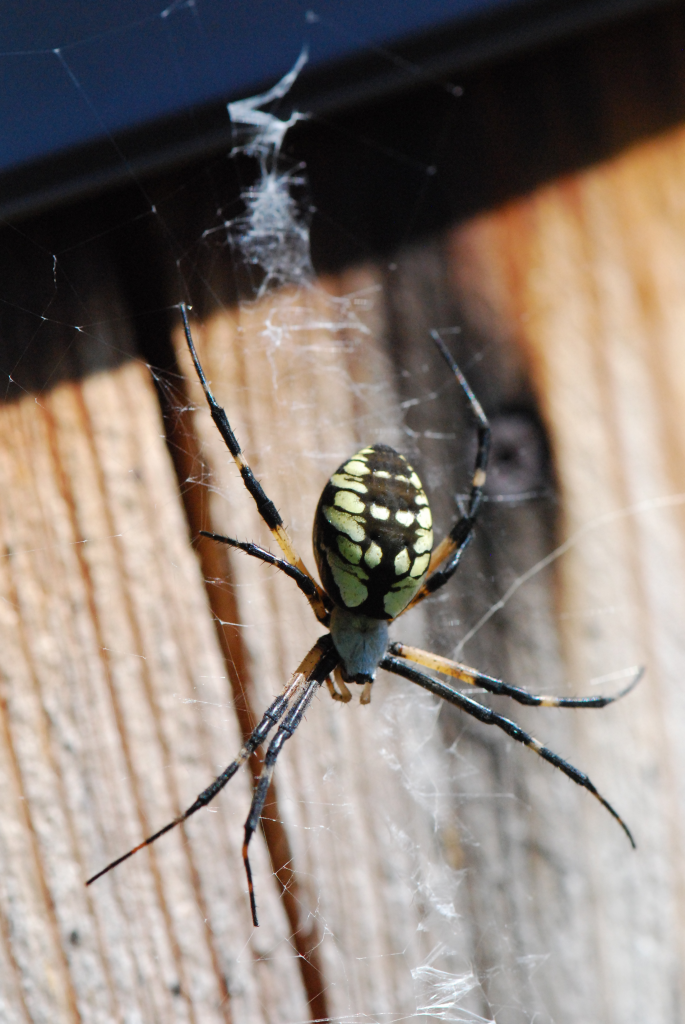
Great Spangled Fritillary, June 2015 – I like it’s on my favorite flower; I like I got its face, proboscis, and all 4 legs…. and look how “bad hair day” it is. Look at those eyes. I kept trying. I really do like daisies though. The slight brown wash on his wings near his body gives the illusion of shadow. 35-70mm
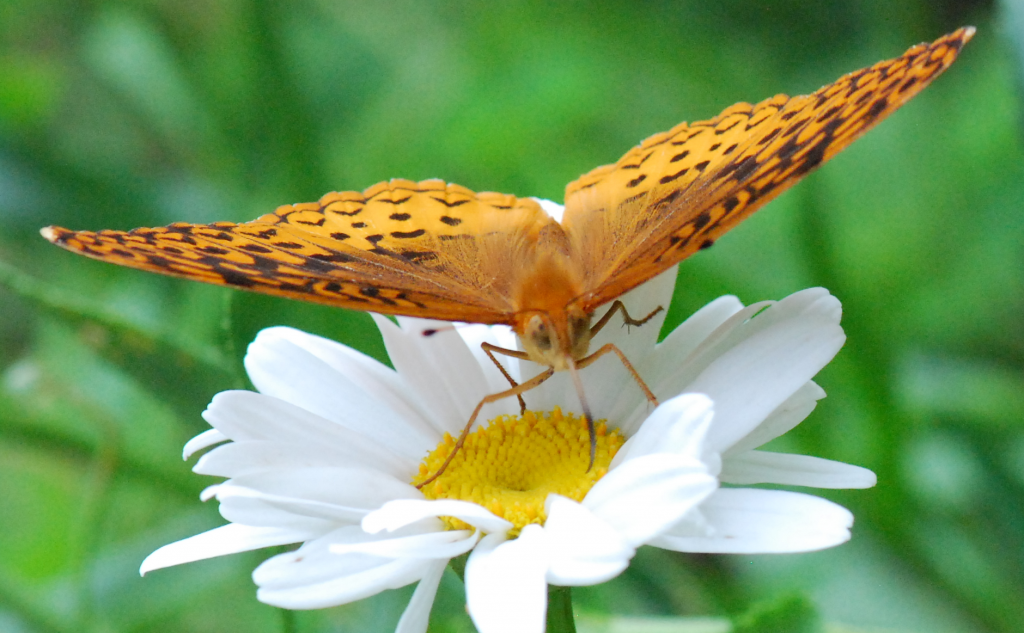
Great Spangled Fritillary – Sept, 2016-17-18 – good overall body and markings; I love the scalloped back wing edge. Look at the fuzzy body; almost looks ‘pet-able’. May be the 10-24mm (I don’t remember exactly when I got the durned thing), else the 105mm; possibly cropped.
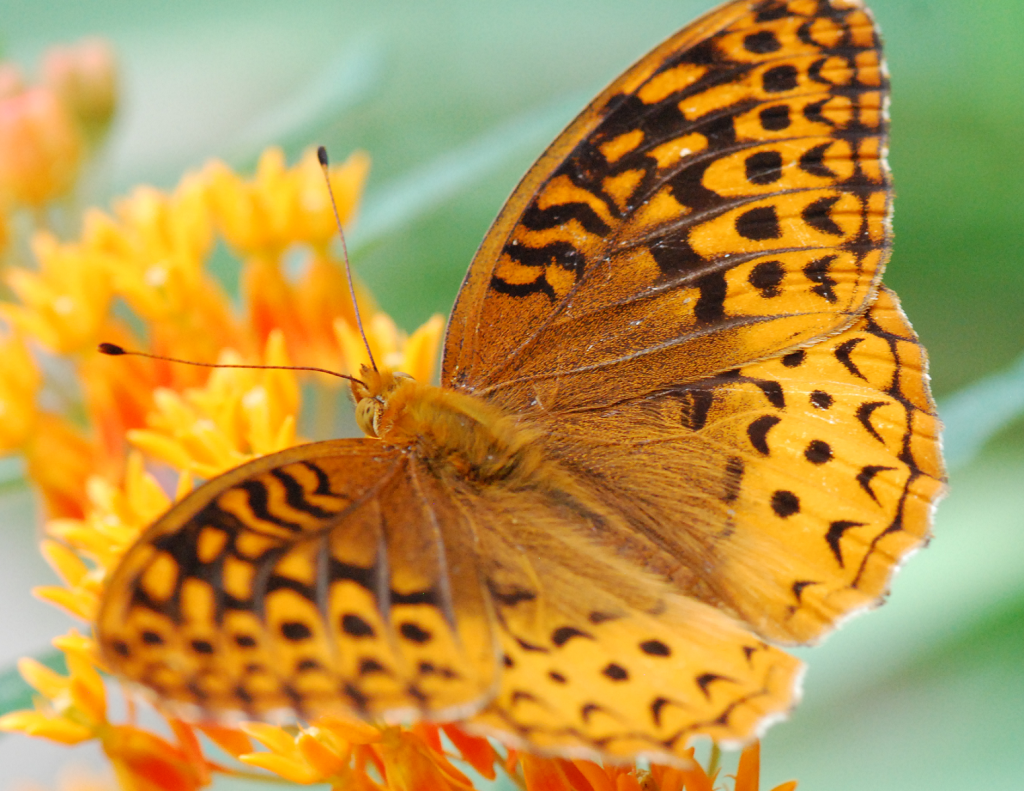
Great Spangled Fritillary Sept, 2016-17-18 – I like that I got the proboscis in action and the sharpness of the face. Doing so meant sacrificing the sharpness of the compound eyes in favor of the proboscis though. And the wings tips are cut off. IDK if that matters in overall composition(?). Pros know how to get more depth to remain in focus, and have more of the butterfly in sharp detail. It didn’t help that the butterfly is nearly the same color as the butterfly weed bloom, either. Same photography session and circumstances as above image.
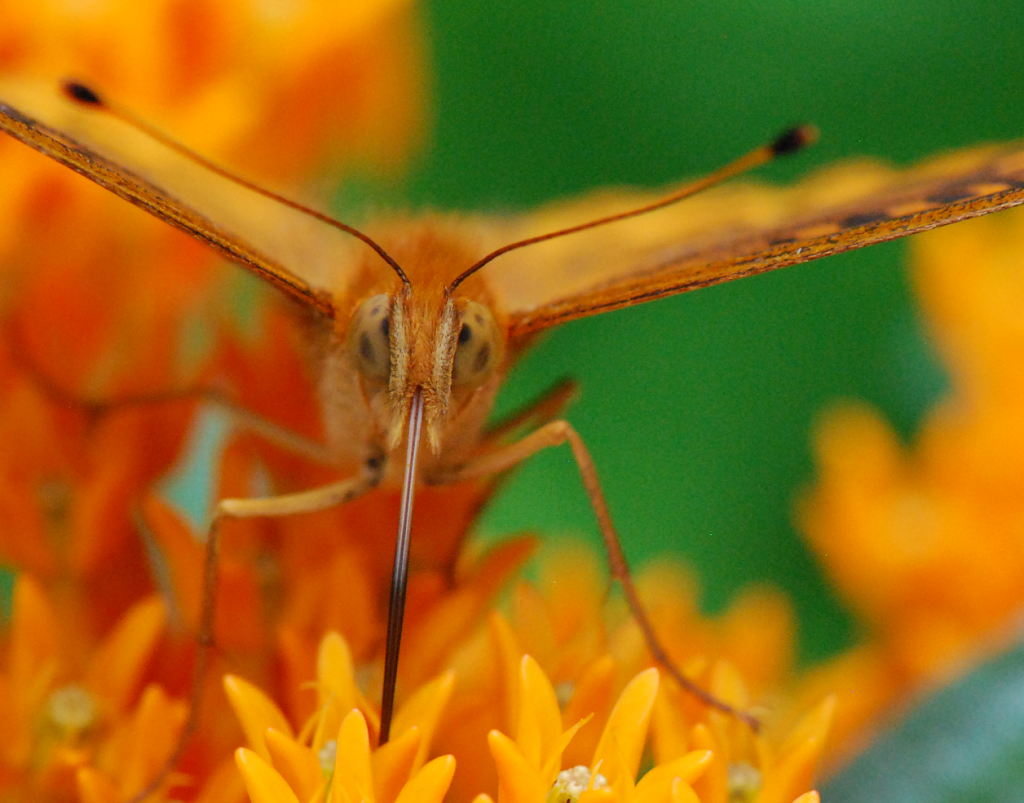
This is a neat looking guy. Shaped much like a lightening bug, but about twice as large. Best guess about 2017-18 summer. I like that I captured the “spikey hair” fringe on its antennae, and I really like its deep blue accent color, with orange collar and velvety dark, dark brown, olive, or black overlapping wings. The dew drops on its wings was just gravy for me. Its proboscis color is interesting. Google says may be native moth. Neato critter! I’m surprised there’s still “food” in that wilted, withered looking mistflower bloom. Probably the 10-24mm, not cropped.

Spring, 2015. In laundry room. It’s the first I knew of our light colored brick house west side being an ideal over-wintering area for Asian Ladybugs. They came out around the window frame in droves one warmer early spring afternoon. I used search engine to look up and identify. I liked the way they lined up like soldiers, with matching shadows. They were seeking a way outside. We later sealed as much as possible of that area of the structure. They are not as good for here, this area, as our native Ladybugs (Ladybirds to some), but they are Ladybugs. 35-70mm

Black swallowtail caterpillar on golden alexander June, 2015. They “throw out” or “raise up” their bright orangey-red antennae when they’re startled or feel threatened. Try not to do that to them. I think it realized I was there just as I snapped. Its head and face appears a bit less in focus. Probably the 35-70mm
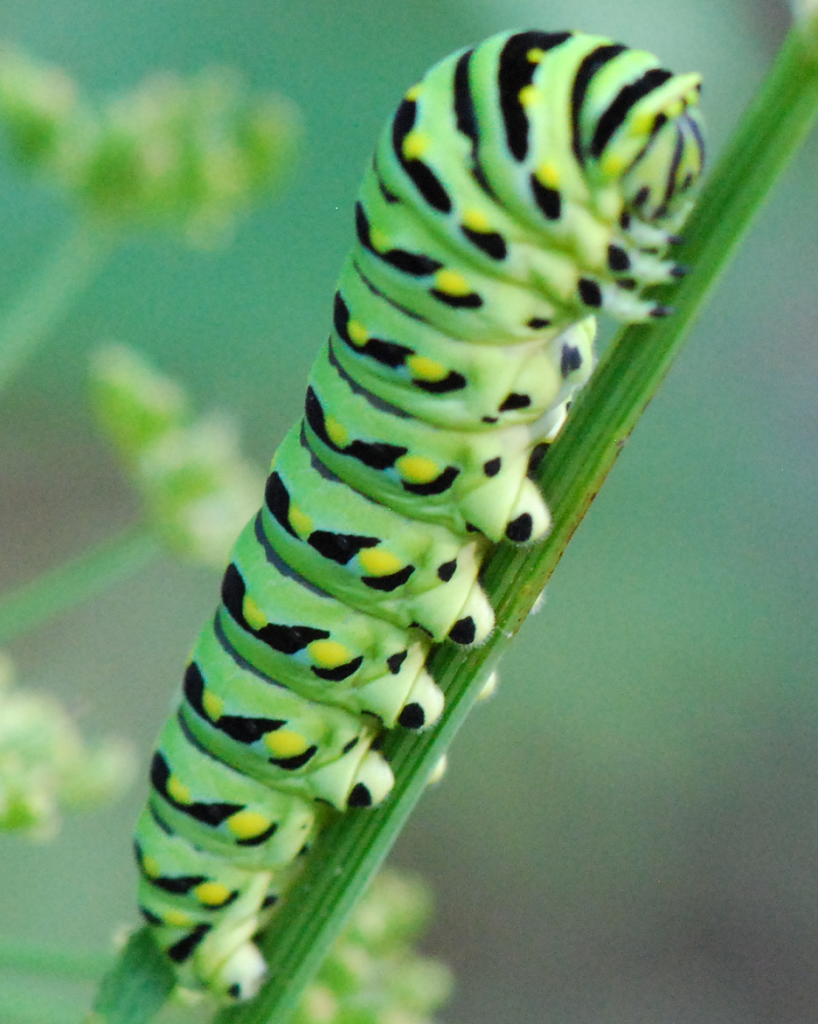
I’ve seen these guys around the pond before. IDK what it was doing over by the west butterfly garden one afternoon last (2019) year. Its at the top of a bamboo support pole, about 9ft from ground level. I like the transparency of the double set of wings but not so much that I can’t really see its body or head very well. These guys dart a lot (not as much as the pretty blue ones) when over by the pond, and rarely land. From my reading, they’re apparently hunting. Probably the 10-24mm.
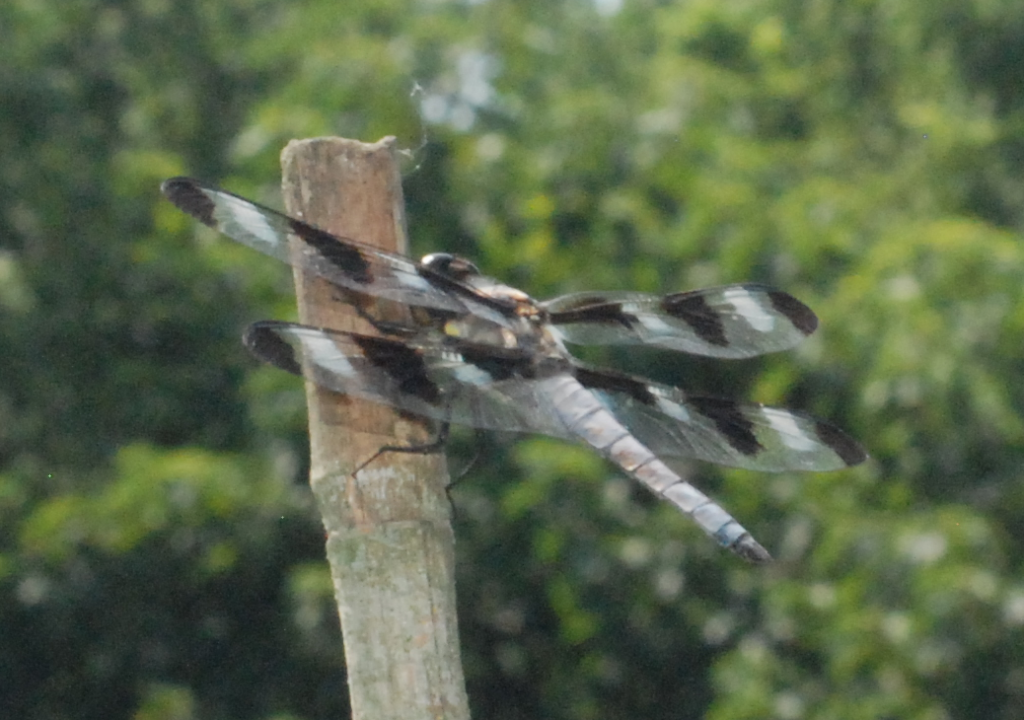
It is so hard to get a good picture of a black cat or dog. I periodically need to do this in my rescue work. This is Mickey, a young, adult male cat, taken in Sept, 2014. No, I didn’t pose him, he just was gracious enough to lay on the magazine or whatever it was I was trying to read. I love the reflected colored light on his whiskers and fur. He was adopted in early 2017. Probably the 35-70mm, maybe the 105mm. Resized down for display, slightly cropped.
